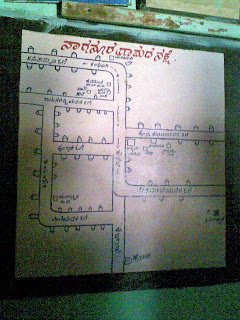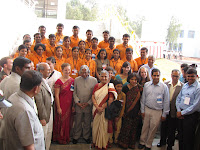
Friday, February 20, 2009
Guest speeker Ayyappa M.Masagi..........

Sunday, February 15, 2009
a
Naganoor Village study
First day we have visited to Gram chetan, it was very nice.It fully covered by trees. Mr. Deepak Kshira Sagar introduced about Gram chetan & he has shared his experience about significant of people participation. Building participatory approch among the people is very important. on one can’t build within a day/over night. Initially they have faced more problems to work with people. While selecting the people they didn’t have any restriction. he told that With support of community they built check dam at Harogere. He shared live examples with us.
Conducted PRA At Kamplikoppa:
We have visited to Kappalikoppa to conduct PRA. The community people welcomed us applying Kumkum & turmeric powder. We have divide in 5 groups. Each team was going to do different activity such as Resource map, Seasonality Map for income & migration, Venn diagram, FGD on milk production. Matrix rank for compose. We conducted Time line on sanitation. Then we can understand PRA by practically. After that I moved to Kmapli Koppa along with my co-fellows. We had practical experience of the PRA. I have been in Seasonality mapping. We did the seasonality map for income & migration. There was very less migration because they depend on irrigation land. & they will get job at VRL it is very near to Villagers.
After coming back from village, we have enjoyed by dancing, singing & making jokes with our Director Naveen Jha, Chinnababu & all co-fellows.
Village Study at Naganoor:
The Naganur village comes under Khalgatigi Taluk, Shurshetti Koppa Panchyath of Dharwad district. It is 25 km away from Hubli city. Only road transportation available for this village. Our team members and me visited this village on 11th and 12th of Feb 2009.
History of the village:
‘Naganur’ means village of snakes. We got different stories from the people regarding village history. One of the elders said that the village was called Laxmipura after that it changed into Yalghatigi Nagnur and Nagnur. Other sources said that some body found Nagalinga in the village long back ago that is why villagers named it as a Naganur.
Transect Walk
On 11th Feb 2009 in the morning we went to Naganur by walk it was 2km from Grama chetan, road was not good. On the way we saw ground nuts, cotton, and sugarcane & sunflower crops in field. We met and asked some youths & old mens about the village.few of them helped us for transect walk. We observed that houses are built very systematically on road side by side. In the entrance of the village there were new houses which is alloted by Govt. Roads are very big. Majority of the houses were Kachha in the village
When we entered into the village, people were busy with their works. They were waiting for bus at Basavanna temple, some people were going to the field, and others are having tea at hotel & children were playing in front of community hall. There are 5 temples in the village; Basavan Temple, Devamamman Temple, Hanuman Temple & Durgamman temple,Dyamavva Temple. we found some of the major institition in villege such as primary school, Anganwadi, community hall, Milk Dairy, Panchayath office,and Durga.
Village was clean. Everyone has drawn rangoli in front of their houses. It shows their indigenous knowledge, local customs & practices. Rapport building was main challenge for us. As soon as we entered the village we initiated rapport building.
When we met people our team members were saying “ Namskara “ to villagers. We clearly explained them reason for coming to their village. Afternoon we visited field we collected some information regarding soil and crops.
It was the late evening when we started our activities because people still returning from the fields. Later we gathered the people for social mapping.
Focus Group Discussion
We conducted focus discussion group in the evening. We have collected information about health & sanitation. But, gathering pople is very difficult. When we called people no one came because they were busy with their work & they neglected us. So we have gone to apply kunkuma door to door & someone we met on road we applied them. We told them to gather round in public place. After gathering Mrs.Jayashree villagers sang welcome song. Later we discussed.
Social Map

A social map has helped us to understand about Nagnur village. This map is drawn by village people and which shows the social structures and institutions found in an area. It also helped us to learn who is living where & about where is temples, school, Community hall, Anganwadi & other offices.
Time Line
Our team has decided to draw the time line map. Mainly our targeted group was women and we called them traditional way putting KUNKUM on their forehead. And we did time line comparative study between situations in 1970 periods and now. Before 1970 the cholera, pelage & T.B like that disease was there. But, now AIDS, Cancer & Chicken gunny. Everyone believed on Ayurvedic treatment. Before 1970 they didn’t have hospital facility, Toilets, Pure water facility, Transport facility & Schools. Now they have school so every child getting literacy, they are growing other crops like suppota trees & mango trees, everything has changed the ladies didn’t not know about bank but now they can easily do bank transaction. Like that there village has changed.
Matrix Ranking
we conducted matrix ranking on compost. by this we understood diffrent types of compost. which compost they will use more & which is the good.

The Resource map has helped us to learn about community & its resource base. To learn the villagers perception of what natural resource are found in the community and how they are using. We started in the next day morning after gathering people we have introduced about resource map we have given rangoli powder to draw. We also took care about involving people. They have drawn water source, different type of soils, Hills, roads, lake, & grazing land.
Secondary Data collection
For collecting secondary data we have visited Anganwadi, Panchayt, Milk Dairy, and Mahasangha & Village Accountant. In that village 1390 population are living 686 male & 704 are female. The voters are 891. It has 360 families. Only one house is Pakka remaining all are kachha house. Big formers are 5, Medium formers are 132 & small formers are 172. The total land is 1982.2 Hectors.
Observation
· Female population is very high.
· Mentally challenged children.
· Village was clean.
Learning
1. Rapport building with villagers.
2. Challenge faced
· Gathering people.
· Misconception from us.
Summary
We had village study. we conducted PRA in Nagnur village of Kalgatgi Talku Dharawad dist. This exercise helped in understanding village situation, developing the rapport with the villagers, their overall developmental & if you want implement any project involvement of people is very important.
Monday, February 9, 2009
Ignited Mind Person Dr.A P J Abdul Kalam.

Sunday, February 8, 2009
Gururaj Desh Speech Impressed to me.
Monday, February 2, 2009
Public Health Module.
On 02 February, 2009 module on Public Health has taken by Meenakshi Agarwal. She has completed her masters in public health and presently serving Deshpande Foundation as a Program Manager-Global Exchange. Previously she has worked for Apnalaya in Mumbai.she has really passion to work in health sector.
Started with the introduction of the group members, by sharing Name, background and the activity done during the week end. It was a good activity at the beginning of the day’s process to learn about Public Health. The faculty person started the session with introduction and definition to Public Health. After providing a brief idea about PH, a small tale film was screened on Indore. The tale film consisted of the approaches that were used to provide Public Health in the area of slums which are in and around Indore.
She has given some short of Questions:
What were the 2 approaches used in the Indore Urban Health Project?
Who were the major stakeholders in this project?
Which one do you think worked better and why?
What would you change, if anything, about this intervention?
Sunday, February 1, 2009
One Day trip to Hampi.
